U.S. Department of Transportation
Federal Highway Administration
1200 New Jersey Avenue, SE
Washington, DC 20590
202-366-4000
Federal Highway Administration Research and Technology
Coordinating, Developing, and Delivering Highway Transportation Innovations
|
R&T NOW This newsletter is an archived publication and may contain dated technical, contact, and link information. |
|
| Publication Number: N/A Date: November/December 2015 |
Publication Date: November/December 2015
|
PDF files can be viewed with the Acrobat® Reader®
FHWA Provides Training to NHTSA Special Crash Investigation Members
In collaboration with FHWA’s Office of Safety Research and Development, the Resource Center recently developed and delivered 2 days of training at the Turner-Fairbank Highway Research Center (TFHRC).
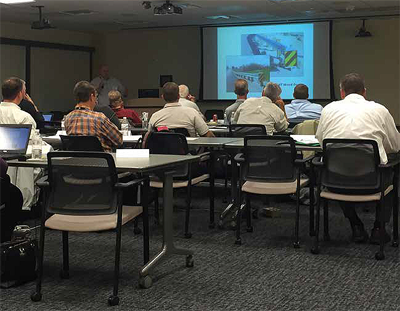
NHTSA's SCI team attends training at TFHRC
The training was for members of the National Highway Traffic Safety Administration (NHTSA) Special Crash Investigation (SCI) team who will be working with FHWA to conduct crash investigations in several States as part of FHWA’s Pilot In-Service Performance Evaluation (ISPE) of Guardrail End Terminals.
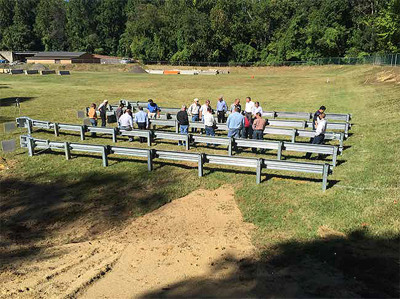
NHTSA's SCI team studies guardrails at TFHRC
The objective of this study is to evaluate the in-service crash performance of some of the most common W-beam guardrail end terminals currently installed throughout the United States.
For each device, the evaluation will address:
Active partners in this effort include staff from NHTSA, FHWA divisions, and departments of transportation (DOTs) in four States where FHWA plans to collect data.
For more information, contact Monique Evans, 202-493-3074, monique.evans@dot.gov.
FHWA to Help NCHRP Accelerate Research Results
On October 21 and 22, 2015, FHWA Associate Administrator for Research, Development, and Technology, Michael Trentacoste, participated in the National Cooperative Highway Research Program (NCHRP) Project 20-44, a process improvement taskforce seeking to accelerate the NCHRP process and the implementation of research results. The panel, consisting mostly of representatives from State DOTs, is reviewing potential methods to speed up the consideration and application of results.
Potential methods include the consideration and incorporation of future implementation issues (e.g., an audience for the product, implementation steps, and costs, etc.) into each project contract at inception and added communication of final results by the Transportation Research Board (TRB). Under consideration is the use of FHWA’s Technology and Innovation Deployment Program activities—such as the Every Day Counts (EDC) initiative and Accelerated Innovation Deployment (AID) Demonstration grants—to support quick implementation of priority, market-ready results. Results of the panel’s deliberations should start to find their place in new contracts issued by TRB in NCHRP’s 2016 fiscal year and in upcoming recommendations to FHWA for the fourth round of EDC.
The NCHRP, which produces about 30 to 40 research reports each year, is an applied research program intended to address the day-to-day issues faced by practitioners in State DOTs through products that can be readily implemented.
For more information, contact Hiwot Abdi, 202-493-3999, hiwot.abdi@dot.gov.
FHWA Discusses Common Interests with Army ERDC
On October 28 and 29, 2015, staff from FHWA’s Office of Infrastructure Research and Development met with a delegation from the U.S. Army Engineering Research and Development Center (ERDC).
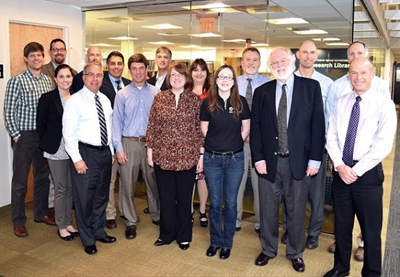
FHWA and Army ERDC staff at TFHRC
The objective of the meeting, which took place at TFHRC, was to share current and planned activities and identify areas of common interest and opportunities for collaboration. These areas include highway materials, asset management, structures, hydraulics, geotechnology, and infrastructure security.
For more information, contact Cara Fitzgerald, 202-493-3376, cara.fitzgerald@dot.gov
EAR Program Funds New Research on Data Mining and Freight Modeling
FHWA’s Exploratory Advanced Research (EAR) Program funded four new research projects in the areas of data mining techniques and freight modeling. Two projects, with the Palo Alto Research Center and with CUBRC (in conjunction with SUNY at Buffalo), will explore suitable methodologies for handling, processing, and analyzing massive data sets relevant to safety data. These projects are being undertaken in response to the Second Strategic Highway Research Program. The two freight projects, with the Massachusetts Institute of Technology and with the Resource Systems Group (in conjunction with University of Washington, University of Toronto, Significance, and Washington State Department of Transportation), will look to create innovative and applicable methods and tools to collect, develop, and integrate freight-related data. These two projects, which will have a special emphasis on geographic, temporal, and cost elements enhancements for use at the national level, will also aim to demonstrate approaches for a national-level, disaggregated, behavioral-based, and multimodal freight demand modeling tool that provides a significant enhancement over current methods for evaluating freight policy alternatives and their impacts.
For more information about the EAR Program or the new research projects, contact David Kuehn, 202-493-3414, david.kuehn@dot.gov.
FHWA Opens Door for U.S. Entities through Infravation Program
Together with European road authorities and the European Commission, FHWA is funding a pooled fund research program called Infravation—the convergence of infrastructure and innovation. With FHWA’s contribution, the door was opened for U.S. entities—universities, States, and contractors—to bid on the work either as leads or participants.
Grant agreements totaling about $11 million are going to nine teams who came out on top of a highly competitive process. Of the nine teams, seven of them include members from the U.S. entities, and three of the projects are being led or coordinated by a U.S. entity.FHWA provided around $1.5 million of the total.U.S. entities include: Arizona State University, Georgia Department of Transportation, Georgia Tech, Texas A&M University, University of California Los Angeles, University of Miami, Western Research Institute, Alta Vista Solutions, Owens Corning, and Pointivo.
FHWA involvement in Infravation not only provides employment for the U.S. entities directly involved, but also opens the door for them to provide technology and innovation transfer directly to the European road authorities and eventually contractors who will be picking up the innovations.
For more information, contact David Kuehn, 202-493-3414, david.kuehn@dot.gov.
New Technologies Guide Blind Pedestrians Safely
FHWA’s EAR Program is sponsoring research that is adapting sensor and guidance technology found on luxury passenger vehicles for use by blind and vision impaired pedestrians. As related projects are nearing the end of program funding, researchers are demonstrating proof of concept systems. Recent demonstrations brought together leaders across government, potential future funders, and community stakeholders.
For more information, visit www.fhwa.dot.gov/advancedresearch/pubs/15040/index.cfm or contact David Kuehn, 202-493-3414, david.kuehn@dot.gov.
Turner-Fairbank Hosts Workshop on Cementitious Materials
On October 22 and 23, 2015, FHWA’s Office of Infrastructure Research and Development in coordination with FHWA’s EAR Program held a workshop at TFHRC that brought together investigators from EAR-funded projects on cementitious materials, collaborators, researchers, and potential end users to discuss technical and potential downstream development issues.
These EAR projects focus on the mechanisms of hydration and setting of ordinary portland cement (OPC); novel alternative cementitious materials for the development of the next generation of sustainable transportation infrastructure; and inorganic polymers—novel portland cement free binders for transportation infrastructure.
Several researchers discussed new methods for measuring, understanding, and modeling cement reactions at the molecular, nano, and microparticle scale, as well as progress on recent TFHRC cooperative research and development projects with two developers of commercial technologies for making concrete without OPC. Researchers from the materials and structures laboratories at TFHRC are helping to advance these projects through the development of techniques, understanding, and performance specifications.
For more information, contact David Kuehn, 202-493-3414, david.kuehn@dot.gov.
FHWA Offers Expertise on UHPC Connections Technology
FHWA recently offered its technical expertise during two activities that focused on discussing and demonstrating the benefits of ultra-high performance concrete (UHPC) connections for prefabricated bridge elements—an Every Day Counts (EDC3) innovation and initiative.
The first activity was held October 19 and 20, 2015 at the Pulaski Skyway in Newark, New Jersey, where a bridge redecking project is underway. It brought together three members of FHWA’s EDC3 UHPC Connections Deployment Team (Ben Graybeal, Mark Leonard, and Jamal Elkaissi) and representatives from the Minnesota Department of Transportation. Graybeal, who heads FHWA’s Bridge and Foundation Engineering Research team and its Structural Concrete Research Program, explained how UHPC connections technology is being used to redeck the 3.5 mile long bridge (just west of the entrance to the Holland Tunnel), which serves as a vital surface transportation link.
The second activity, held on October 21, 2015, was a full-day workshop on UHPC Connections technology that Graybeal delivered to the Vermont Department of Transportation and its local consultants. The workshop was well received by 35 attendees who each are playing a role in advancing Vermont toward its first deployment of this technology in early 2016.
For more information, contact Ben Graybeal, 202-493-3122, benjamin.graybeal@dot.gov.
New Book to Feature Wood Trusses and Covered Bridge Construction
FHWA’s Office of Infrastructure Research and Development and the Historic American Engineering Record (HAER), a division of the National Park Service (NPS), Heritage Documentation Programs, have maintained a joint research and technology program for historic covered bridges since 2002. This partnership has included a variety of initiatives, such as documentation for the HAER collection at the Library of Congress, engineering studies, National Historic Landmark designations, conferences, and a traveling exhibition. All of these products are the result of cooperative research under FHWA’s National Historic Covered Bridge Preservation (NHCBP) Program. One of the culminations of this multiyear program is the publication of Covered Bridges and the Birth of American Engineering, edited by Justine Christianson and Christopher H. Marston.
The book examines the development of wood trusses and covered bridge construction, profiles the pioneering craftsmen and engineers involved, explores the function of trusses in covered bridges, and looks at the preservation and future of these distinctly American bridges. The book is generously illustrated and includes photographs and drawings chosen from a vast collection at the Library of Congress. It also includes historic images and engineering diagrams. The book is intended to show a new appreciation for the role that covered bridges played in the development of the Nation and in American bridge engineering.
The publication is scheduled to be released in December 2015 and will be available via http://woodcenter.org. For more information, contact Christopher Marston, 202-354-2162, christopher_marston@nps.gov, or Sheila Duwadi, 202-493-3106, sheila.duwadi@dot.gov.
FHWA’s NDE Project to Assist SCDOT, Advance Assessments of Flooded Pavements
An FHWA research project focused on the nondestructive evaluation (NDE) of pavements subjected to flooding in South Carolina is expected to generate guidelines for assessing flooded pavements. Findings from this project could help the South Carolina Department of Transportation (SCDOT) and other State DOTs more accurately predict the condition of flood-affected pavements and inform decisions regarding the opening or closing and repair of roads.
Led by a University of New Hampshire multi-institution team, the project involves collecting and analyzing in-place data to validate and calibrate the results of theoretical analyses and laboratory testing. Researchers from Worcester Polytechnic Institute and Infrasense will conduct falling weight deflectometer (FWD) and ground penetrating radar (GPR) testing of a set of road sections that have been recently subjected to flooding in South Carolina.
Working closely with FHWA and SCDOT, the team plans to identify sections of roads to test that represent a wide variety of road structures in terms of materials, thickness, traffic, and layout. Pavement sections that have not been subjected to flooding will also be tested to collect baseline/control data. The GPR data will help identify areas with voids and base and subgrade saturation, any discontinuities in layers, and determine thickness and moisture contents of different layers. The FWD and the GPR data will help identify any structurally weak areas and help ascertain the stiffness of the different layers, which could be used for estimating the structural capacity of the road sections.
In coordination with SCDOT, researchers have begun the testing and will continue it at specific intervals in the near future to monitor the gradual gain in strength of the pavements. These data, along with material, construction, and before-flooding FWD data from SCDOT, could prove instrumental in understanding the loss of structural capacity of different types of roads during and immediately after flooding, and the recovery of the capacity over time.
For more information, contact Katherine Petros, 202-493-3154, katherine.petros@dot.gov.
LTBP Program Holds Webinar on Bridge Portal
On October 15, 2015, FHWA’s Long-Term Bridge Performance (LTBP) Program held a Webinar to provide information about its Bridge Portal Version 1, a Web-based application interface capable of providing storage, access, analysis, and visualization of various data sources related to bridge performance on a network or individual basis.
The Webinar was well-attended and introduced the Bridge Portal to division and field offices and State highway agencies. It provided information on how to gain access to the application and offered a broad overview and demonstration of the Portal’s capabilities. The Webinar also included a short question and answer session and allowed attendees to comment on the usefulness of the application.
The LTBP Bridge Portal is currently populated with historical National Bridge Inventory data (from 1992 to the present). National Bridge Element data, LTBP field-collected data, and other bridge-related data that support capturing bridge performance will be incorporated into the data warehouse of the Portal as they become available. Future versions of the LTBP Bridge Portal will provide additional capabilities such as deterioration and forecasting models, and enhanced geographic information system (GIS) mapping. The Portal is expected to be of particular interest to FHWA division bridge engineers and their counterparts at State DOTs and local agencies who are interested in bridge performance-related information.
Employees of FHWA, State DOTs, and local agencies can access the LTBP Bridge Portal through FHWA’s User Profile Access Control System (UPACS). FHWA users must log in with UPACS credentials, while State DOT and local agency employees must log in with Operational Research Consultants (ORC) credentials. Access to UPACS as well as instructions for State DOT and local agency employees on obtaining ORC credentials can be found at https://fhwaapps.fhwa.dot.gov/upacsp/. Other users will need to request access to and register for the Portal via https://fhwaapps.fhwa.dot.gov/ltbpp/.
For more information, contact Robert Zobel, 202-493-3024, robert.zobel@dot.gov.
Pavement Software Features New Traffic Defaults from LTPP
This fall, the American Association of State Highway Transportation Officials (AASHTO) implemented new traffic loading defaults developed by the Long-Term Pavement Performance (LTPP) program in its AASHTOWare® Pavement ME Design Software.
In 2012, the LTPP program completed a data analysis project that evaluated the applicability of the existing global traffic loading defaults used in the Mechanistic-Empirical Pavement Design Guide (MEPDG). The project used weigh-in-motion (WIM) data from the LTPP program’s Specific Pavement Study experiments to improve the global axle loading values included in the original 2008 defaults.
The MEPDG methodology, which was developed under National Cooperative Highway Research Program Project 1-37A, requires actual traffic inputs. Since the cost to collect these inputs is not possible for the majority of highway agencies, most pavement designs developed using the MEPDG rely on regional, agency-wide, or national traffic loading defaults. Therefore, it is important for the default values to be representative of the actual truck loadings for a project site.
The original traffic default values used in the MEPDG were based on LTPP traffic data collected by highway agencies prior to 1999. At that time, these data represented the best available and most comprehensive national set of WIM and automated vehicle classification data. Since 1999, the LTPP program has generated high-quality traffic loading information for some of its test sites. These data are being collected using standard protocols for data collection consistency and improved data quality assurance. As a result, these new data provided an opportunity to improve the axle loading traffic defaults in the MEPDG for highway agencies
For more information, contact Deborah Walker, 202-493-3068, deborah.walker@dot.gov.
Saxton Lab Demonstrates Multivehicle Platooning Using CACC
Together with its partners, FHWA’s Saxton Transportation Operations Laboratory recently conducted a five-vehicle platoon test on an inactive air base in Willow Grove, PA. The team that conducted the test was comprised of transportation experts, researchers, and engineers from California Partners for Advanced Transportation Technology, Leidos, FHWA, and TORC Robotics. To demonstrate platooning and expand on current connected vehicle (CV) research, the team spent two weeks at the base testing a fleet of Cadillacs equipped with cooperate adaptive cruise control (CACC).
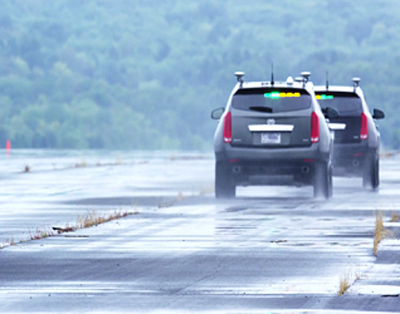
Two Cadillacs demonstrate CV technology
Using CACC and dedicated short-range communication, the Cadillacs were able to wirelessly communicate their speeds and distances with surrounding vehicles to avoid following too closely or stopping too abruptly.
The connectivity between the vehicles allowed them to accelerate and decelerate based upon fixed following distance settings and speeds. It also established precise distances between each vehicle and allowed the vehicles to come to a complete stop in unison.
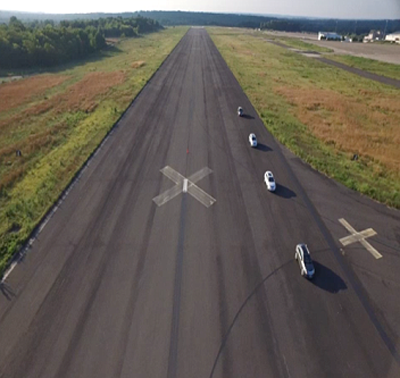
Four vehicles using CACC
The team demonstrated a number of different maneuvers and showcased a selection of them to leadership from TFHRC. This groundbreaking technology, which is essential for improving roadway safety and efficiency, could be a future solution to congestion and traffic incidents as it can prevent unnecessary braking and establish safe and constant speeds with other vehicles.
For more information, contact Taylor Lochrane, 202-493-3293, taylor.lochrane@dot.gov.
SBIR Program to Advance Safety through Smartphone App
FHWA, through the U.S. Department of Transportation (USDOT) Small Business Innovation Research (SBIR) Program, recently awarded a contract to Savari Inc. to develop a traffic signal interface application (app) for smartphones called SmartCross. The app will interface with traffic signal systems that control traffic lights and receive information about pedestrian signals.
The technology will be able to send signals between the pedestrian’s phone and the nearest traffic signal box, notifying pedestrians when it is safe to step into the crosswalk. It will also allow users to request pedestrian signals. For enhanced safety, the app will provide audio, visual, and haptic (typically vibration) feedback to the user.
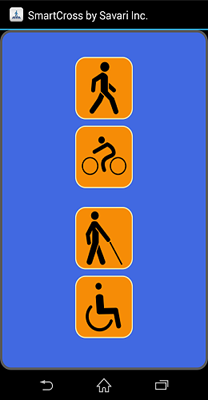
SmartCross app
The technology will feature different modes for pedestrians, bicyclists, visually impaired individuals, and people in wheelchairs. For example, to assist the elderly and the physically impaired, the app will be able to send a request for extra pedestrian crosswalk time. Drivers will also benefit from this technology. Vehicles equipped with an onboard unit will be notified of a pedestrian in an active crosswalk via an in-vehicle display. The screen will also display the colors of the changing light and how much time remains for each color.
The app is currently under further development, but will soon be available to iPhone and Android users. After its launch, developers will continue to update the app to leverage the latest technology. Enhancements to the application are expected to advance new research for accessibility and mobility.
USDOT announces new topics each year through its solicitations, supporting projects like the SmartCross app to develop technological innovation using the highest level of expertise in the small business community.
For more information, contact James Pol, 202-493-3371, james.pol@dot.gov.
ATTRI and ODEP Host Online Dialogue
The Accessible Transportation Technologies Research Initiative (ATTRI)—a joint USDOT initiative, co-led by FHWA and the Federal Transit Administration (FTA), with support from the Intelligent Transportation Systems Joint Program Office—together with the U.S. Department of Labor’s Office of Disability Employment Policy (ODEP) recently hosted an online dialogue to promote innovation around the design of accessible transportation options related to employment.
The online dialogue was focused on gathering insights and ideas for the future generation of accessible transportation solutions, including connected and automated vehicles, to further develop and enhance transportation options as an effective employment support for people with disabilities. The mobility of travelers with disabilities, including veterans and older adults, is hindered by a lack of accessible transportation options. A number of emerging personal mobility options can change this and provide better options for all travelers to get from Point A to Point B, which includes to and from places of employment. Whether it be on-demand operations, virtual concierge travel assistance through mobile devices, or assistive robots, research in accessible transportation has gained new momentum in recent years.
During the online dialogue, the following questions were posed: What new technologies should be developed to enhance personal mobility and accessible transportation options for older adults and people with disabilities (such as wearable devices—for example, smartphones, smartwatches, smartdevices, and social media sources)? What existing application programming interfaces (APIs) and open source code could be used to create new transformative accessible transportation applications?
Ensuring that more workers remain employed despite a challenging health condition will require strong policy leadership, targeted research, effective social marketing, and a sustained attention to essential technical details regarding payment mechanisms and data capture. Input from this online dialogue will be used to help inform the development of an innovation challenge to support the development of innovative accessible transportation solutions that benefit all travelers, including those with disabilities.
For more information, contact Mohammed Yousuf, 202-493-3199, mohammed.yousuf@dot.gov.
USDOT Hosts Enabling Technologies Workshop
On November 9, 2015, USDOT hosted an enabling technologies workshop at its headquarters in Washington, DC. The workshop encouraged participants to consider what technologies are necessary for self-driving vehicles, whether USDOT should standardize mapping for automated vehicle technologies, and the importance of artificial intelligence in vehicle automation.
Vehicle automation relies heavily on technologies such as wireless communications, mapping, positioning, navigation, timing, and sensing. Applications planned within USDOT’s automation research roadmap depend on understanding these technologies and their applicability. The workshop focused on recent technological advances that have potential to enable vehicle automation. Participants were encouraged to consider how these advances relate to USDOT’s vehicle automation program.
For more information, contact Mohammed Yousuf, 202-493-3199, mohammed.yousuf@dot.gov.
ATTRI Mentioned in Committee’s Report to President
ATTRI was recently mentioned in “Leveling the Playing Field: Improving Technology Access and Design for People with Intellectual Disabilities,” a report by the President’s Committee for People with Intellectual Disabilities. Focused on the role of technology in improving the quality of life for people with intellectual disabilities and ensuring their full citizenship rights, the report recognizes that “ATTRI research focuses on the needs of three stakeholder groups: 1) people with disabilities, 2) veterans with disabilities, and 3) older adults.” The report goes on to point out that ATTRI “proposes areas of technology development on: information and technology services and accessible transportation; automation and robotics; data integration; wayfinding and navigation; and enhanced human service transportation.” ATTRI would also like to see the advancement of cloud-based navigational systems, wearable devices, and interactive pedestrian crossing supports.
The report is available to download at www.acl.gov/programs/aidd/Programs/PCPID/docs/PCPID-2015-Report-to-President.pdf. For more information, contact Mohammed Yousuf, 202-493-3199, mohammed.yousuf@dot.gov.
FHWA Releases 2015 Version of IHSDM
FHWA recently released version 11.0.0 of the Interactive Highway Safety Design Model (IHSDM), a suite of software analysis tools for evaluating safety and operational effects of project-level geometric design decisions on highways. The new version includes major enhancements to the policy review module, which was expanded to include policy checks for rural multilane highways. The software is available to download for free at www.ihsdm.org.
IHSDM, which supports the Data-Driven Safety Analysis initiative that is part of FHWA’s Every Day Counts 3 efforts, includes six evaluation modules applicable to rural two-lane highways: crash prediction, design consistency, intersection review, policy review, traffic analysis, and driver/vehicle. The crash prediction module serves as a faithful implementation of the American Association of State Highway and Transportation Officials’ Highway Safety Manual, Part C: Predictive Method. The module deals with two-lane rural highways, multilane rural highways, urban and suburban arterials, freeways and ramps/interchanges.
IHSDM training courses are available through the National Highway Institute. For a 2-day, onsite training course, visit http://www.nhi.fhwa.dot.gov/training/course_search.aspx?tab=0&key=IHSDM&sf=0&course_no=380071. For a Web-based, instructor-led course, visit http://www.nhi.fhwa.dot.gov/training/course_search.aspx?tab=0&key=IHSDM&sf=0&course_no=380100. IHSDM technical support is available at IHSDM.Support@dot.gov and 202-493-3407.
The IHSDM Web site, www.ihsdm.org, includes information related to case studies, past Webinar materials, and frequently asked questions.
For more information, contact Abdul Zineddin, 202-493-3288, abdul.zineddin@dot.gov.
Human Factors Lab to Install New Highway Driving Simulator Vehicle
The Human Factors Laboratory in FHWA’s Office of Safety Research and Development replaced its original Highway Driving Simulator (HDS) vehicle, a 1998 Saturn SL1, with a 2013 Ford Fusion.
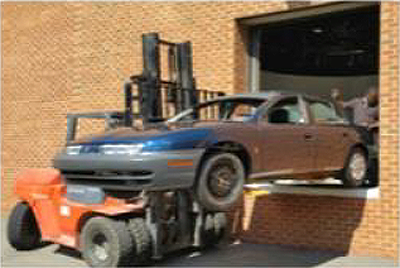
1998 Saturn SL1 being removed from the HDS
Since the Saturn was installed in 1999, more than 20 safety and driver behavior studies have been conducted in the HDS, in which approximately 1,800 participants drove the vehicle for over 90,000 miles of simulated travel. On July 15, 2014, President Barack Obama drove the Saturn when he visited TFHRC.
The Ford Fusion is equipped with several modern features and functionalities, such as a programmable liquid-crystal display center console.
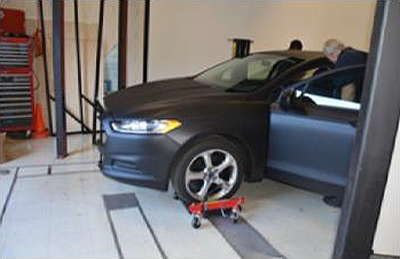
Arrival of the 2013 Ford Fusion
This new HDS vehicle will enhance the Human Factors Team’s ability to continue conducting cutting-edge research in a variety of areas, including connected vehicles and automation.
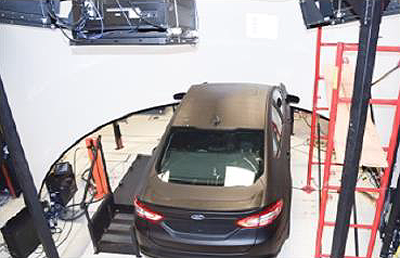
Today, the new simulator vehicle is undergoing
careful installation and rigorous calibration.
Installation of the new vehicle is scheduled to be completed before TRB’s Annual Meeting in January 2016.
For more information, contact David Yang, 202-493-3284, david.yang@dot.gov.
Human Factors Team Demonstrates Prototype Technology at Auburn
On August 17, 2015, the Human Factors Team in FHWA’s Office of Safety Research and Development visited Auburn University for a progress review and a hands-on demonstration of a prototype system for the project, “Extended Event Horizon Navigation and Wayfinding for Blind and Visually Impaired Pedestrians in Unstructured Environments.”
Funded through FHWA’s EAR Program, the multiyear project is focused on developing technology that provides guidance assistance to blind and visually-impaired pedestrians navigating in large, unstructured environments, such as parks, parking lots, airports, complex intersections, and underground transportation locations. The navigation assistance will be accomplished by a combination of advanced inertial sensing technology, dedicated short-range communication, and computer vision systems. Information gathered from the environment is processed in real-time and provides point-to-point guidance and wayfinding to the pedestrian via a human-machine interface (HMI) consisting of a tactile feedback belt.
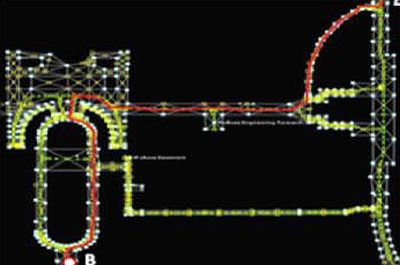
Sidewalk pathway map nodes
The image above represents all known sidewalk pathway map nodes surrounding a university engineering building. During the hands-on demonstration, the Human Factors Team navigated from Point A to Point B (as shown with the red line) using only the information relayed via the HMI from the prototype device.
For more information, contact Jim Shurbutt, 202-493-3420, jim.shurbutt@dot.gov.
STAC Awards Task Orders to Support SHRP2 Safety Data Training
The Safety Training and Analysis Center (STAC) in FHWA’s Office of Safety Research and Development has awarded two separate task orders to provide support to STAC staff to develop training related to safety data from the Second Strategic Highway Research Program (SHRP2). This support will include identifying and documenting requirements to establish secure remote access to SHRP2 safety data, including data containing personally identifiable information.
The safety data from SHRP2 is an unprecedented collection of detailed information on driver behavior, vehicle use, the roadway, and other information about recorded trips. The driver, vehicle, and trip information are referred to as Naturalistic Driving Study (NDS) data. The roadway data is referred to as the Roadway Information Database (RID). The NDS support task order was awarded to Virginia Polytechnic Institute and State University and the RID support task order was awarded to Leidos.
For more information, contact Aladdin Barkawi, 202-493-3312, aladdin.barkawi@dot.gov.
Public Roads—September/October 2015
This issue includes: Taming Cyber Risks; An Array of Possibilities; Making Virtual a Reality; A Golden Opportunity to Make Travel More Golden; The Pennsylvania Turnpike Turns 75; Check Out Your Latest FP; and Powering an Energy Revolution.
It is available online via www.fhwa.dot.gov/publications/publicroads/16sepoct/index.cfm.
For more information, contact TaMara McCrae, tamara.mccrae@dot.gov.
Innovator: Accelerating Innovation for the American Driving Experience—November/December 2015
This issue includes: STIC Incentive Projects Help States Standardize Innovations; Using Regional Models of Cooperation; Connecting with Ultra-High Performance Concrete; WANTED: New Ideas for Innovation Implementation; Adaptive Signal Control Technology Spreads Nationwide; Demonstration Grants Support Cutting-Edge Projects; States Innovate; and Events.
The issue is available online via www.fhwa.dot.gov/hfl/innovator/e-version/issue_51/
Correction:
In the September/October 2015 issue, the name of the report, “Evaluation of Long-Term Pavement Performance (LTTP) Climatic Data for Use in Mechanistic-Empirical Pavement Design Guide (MEPDG) Calibration and Other Pavement Analysis” had a typo in the abbreviation and should be “Evaluation of Long-Term Pavement Performance (LTPP) Climatic Data for Use in Mechanistic-Empirical Pavement Design Guide (MEPDG) Calibration and Other Pavement Analysis.”
Turner-Fairbank Highway Research Center: www.fhwa.dot.gov/research/tfhrc/
Resource Center: www.fhwa.dot.gov/resourcecenter/
National Highway Institute: www.nhi.fhwa.dot.gov/home.aspx
Please forward this newsletter to others you think might find it interesting and/or useful.
Suggestions may be submitted to: FHWA_Now@fhwa.dot.gov